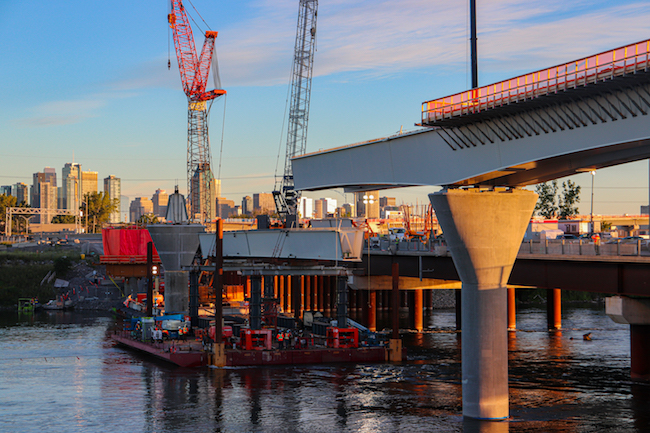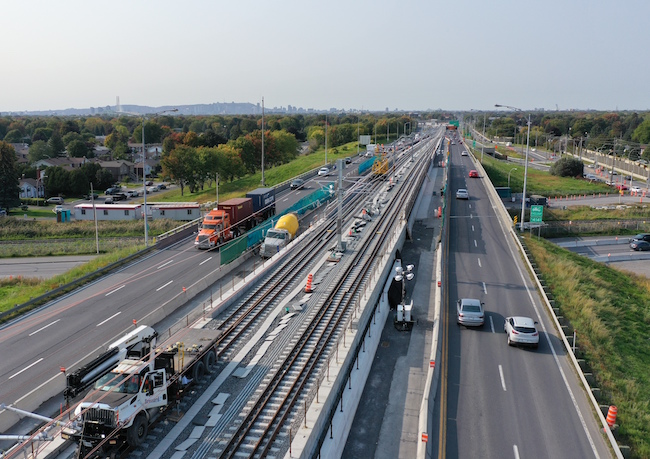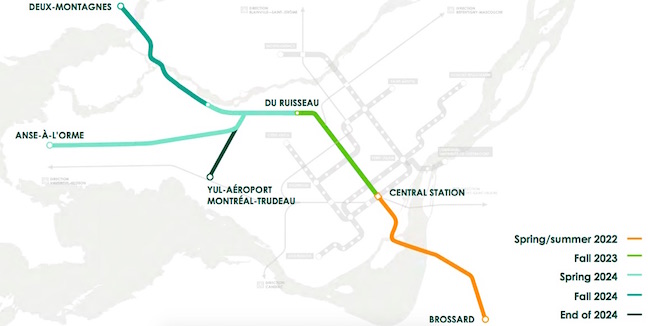
Pandemic, serious tunnel issues to delay portions of Montreal REM up to 18 months
By David Kennedy
Construction
In spite of the challenges, construction has progressed on a range of project elements, including the Île-des-Sœurs Bridge. PHOTO: CDPQ Infra
The complete shut down of the nearly two dozen Réseau express métropolitain (REM) construction sites spread throughout Montreal this May, as well as two significant safety issues with the Mont-Royal Tunnel, will delay all components of the new light rail project by at least three months, and others by as much as a year and a half.
In an update Nov. 11, officials from CDPQ Infra detailed progress on the five main segments of the $6.3 billion transit system, noting the various issues will add up to a year to the light rail project’s overall timeline.
Despite the challenges, Macky Tall, president and CEO of CDPQ Infra praised the tireless efforts of work crews in “a year plagued by unexpected events.”
“Starting this fall, only two years and a few months after the groundbreaking ceremony, REM cars will be circulating on the South Shore and within a few years the REM will be riding in the Greater Montreal area,” he said in a release.
Because the five components of the REM were originally scheduled to open at different times, the roughly 18-month delay to the central segment of the line will not lead to a comparable delay to the entire system. For instance, the opening of the Brossard section, the first element of the project scheduled to reach completion, has been delayed from the end of 2021 until spring 2022. The final portion of the project, the connection to Montréal-Pierre Elliott Trudeau International Airport, had been scheduled to open in late 2023, a date that has been revised to late 2024.

Construction on the light rail project began ramping back up in May after the unexpected spring shutdown caused by the COVID-19 pandemic. PHOTO: CDPQ Infra
CDPQ Infra, the subsidiary of Caisse de dépôt et placement du Québec heading the 26-station project, pointed to the roughly six-week government-mandated shutdown of construction work this spring, new safety measures required on-site and supply chain challenges for most of the delays.
Added costs are guaranteed, Tall acknowledged, but did not point to a specific number. He said teams are “rigorously working” on containing additional expenditures, but with the pandemic still ongoing and uncertainty about how long added job site safety protocols must remain in place, precise figures cannot be calculated.
Along with COVID-19, the project team — comprised of SNC-Lavalin, Dragados Canada, Inc., Aecon Group Inc., Pomerleau Inc. and EBC Inc. — encountered two unexpected and serious issues within the Mount Royal Tunnel this summer. A complicated retrofit of the rail tunnel had already been planned so the new REM could make use of the century-old piece of infrastructure, but the accidental detonation of an old explosive charge and major deterioration have added further complexity.
Shortly after excavation work began in the tunnel on July 20, CDPQ said an unexpected detonation occurred.
“Work was immediately suspended and thankfully no workers were injured,” the company said in a release. “The investigation and enquiry revealed the most likely cause was that workers intersected an old bore hole containing an explosive charge dating back to tunnel construction in 1912.”
Work stopped for months as an investigation was carried out and a strategy for moving forward formulated. Along with other measures, the plan requires establishing worker exclusion zones and using remote-controlled equipment.
Along with the unexpected obstacle of 100-year-old explosives, decades of de-icing salt used on McGill College Avenue atop the tunnel has degraded integral concrete and steel supports. The team uncovered the issue while carrying out intrusive inspections under downtown Montreal, noting that no waterproofing membranes were used on the tunnel walls during the original construction. The deterioration calls for “immediate measures” in the form of reinforcement work, CDPQ Infra said.
“No compromise would be acceptable when it comes to the safety of workers and the public; it is therefore important to take the necessary measures while continuing to manage our schedule in a tight and rigorous manner,” said Jean-Marc Arbaud, executive director of CDPQ Infra and the REM project office, in a release.
Unsurprisingly, the added safety measures and supplemental reinforcing work will slow construction substantially. Instead of spring 2022, the central portion of the REM will not open until fall 2023. The 18 additional months will ripple down the 67-kilometre line, pushing completion dates for the western spurs of the light rail project from 2023 to 2024.





